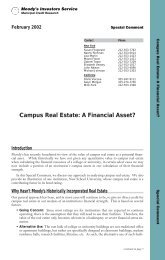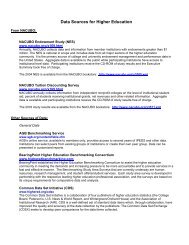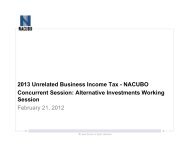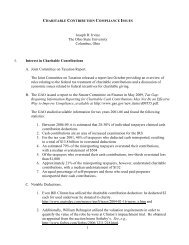March 5, 2003 The Honorable John A. Boehner U.S. ... - NACUBO
March 5, 2003 The Honorable John A. Boehner U.S. ... - NACUBO
March 5, 2003 The Honorable John A. Boehner U.S. ... - NACUBO
Create successful ePaper yourself
Turn your PDF publications into a flip-book with our unique Google optimized e-Paper software.
Recommendations for the Reauthorization of the Higher Education Actto the U.S. House of Representatives Committee on Education and the WorkforcePART II. REGULATORY REFORMAdministrative Burden and Cost. In 1998, members of the National Commission on the Cost ofHigher Education named government regulation as one of six major “Cost and Price Drivers” inhigher education—the others were financial aid, people, facilities, technology, and expectations.<strong>The</strong> commission’s report, Straight Talk about College Costs and Prices, noted the rapid growth inrecent years of the number and types of regulations with which colleges and universities havebeen asked to comply at their own expense. <strong>The</strong> report also noted that in recent years, costs relatedto institutional accreditation have grown as have the number of accrediting bodies, in particular,specialized ones. <strong>The</strong> Higher Education Amendments of 1998 contributed even more toadministrative cost and burden for Title IV institutions via increased regulation and reportingrequirements despite the concerns raised by commission members.<strong>The</strong> implementation of a new regulation significantly adds to institutional administrative burdenand generally results in increased labor cost and expense. Major costs include:► Increased administrative hours and personnel;► Staff development and training;► Establishment of new accounting, record keeping, and reporting systems and procedures;and► Costs associated with purchasing information technology expertise and solutions tohelp create computer programs or entirely new systems to support specific data andinformation collecting activities.At present, the only standard used by Department of Education to measure institutional burdenis limited to an estimate of the hours needed to report the outcomes of compliance activities.This approach obviously does not take into account the majority of costs associated with complyingwith new program requirements.It is important to note that implementation of a new regulation places a strain on institutionalbudgets and that the incremental costs associated with compliance result in reduced services orincreased costs for students. Too often, unbudgeted costs result in the reduction or delay of services.For institutions that have pared their budgets down to the bone in recent years and haveimplemented a host of cost reduction measures, the cumulative effect of increased compliancecosts can lead to reducing access, decreasing the quality of education services, or both. Whenthere are few resources available to operate an institution effectively, these costs are passed onto students in the form of increased tuition and fees.We strongly believe that there are many effective ways to reduce the burden of complying withthe overly complex Title IV regulations. Instead of amending or appending more complicated,confusing, lengthy, and irrelevant layers to the existing rules, why not step back and take afresh approach, i.e. one that takes into account the intent of the law, resulting in a new, updatedand more focused interpretation of the law? <strong>The</strong> outcome could result in great cost savings forall stakeholders in the programs and free up scarce resources to assist prospective and enrolledstudents.National Association of College and University Business Officers 2
















